Travel Trends in Golden Week 2024 (April 25 to May 5)
JTB Corp.
JTB has summarized the outlook for travel trends among people planning overnight or multiple-night travel during the Golden Week (hereafter referred to as "GW") between April 25 and May 5, 2024. This report is a compilation of data about overnight or multiple-night travel made by Japanese travelers estimated based on various economic trends, consumer behavior surveys, transportation and tourism-related data, and surveys conducted by the JTB Group. The survey has been conducted on an ongoing basis since 1969.
●The number of domestic travelers is estimated at 22.8 million (100.9% year-on-year), the average cost of domestic travel at 36,100 yen (103.7% year-on-year), and the total domestic travel spending at 823.1 billion yen (104.7% year-on-year)
●The number of overseas travelers is expected to be 520,000 (167.7% year-on-year), the average cost of overseas travel to be 269,000 yen (104.7% year-on-year), and the total overseas travel spending to be 139.9 billion yen (175.6% year-on-year)
[Domestic Travel]
- The number of travelers is projected to remain at the previous year level partially due to the impact from price hikes while there are favorable conditions with the sharp rise of stock prices.
- The average travel cost (per capita) is expected to increase due to price hikes.
- Many popular travel destinations are relatively nearby, but compared to the previous year, the destinations tend to be spread out, and in terms of transportation, travel by railway and air are projected to increase.
[Overseas Travel]
- The number of travelers is expected to recover to the 80% to 90% pre COVID-19 pandemic level (excluding 2019 when GW was a 10-day consecutive holiday). Since the end of the entry-exit border control measures for COVID-19 was announced right before GW in the previous year, a certain number of people are assumed to have given up overseas travel, and a rebound is expected.
- The average travel cost (per capita) is projected to increase mainly due to the weak yen and price hikes.
- The intent to travel is high, but due to the sharp rise in travel costs, popular destinations are nearby, and Asia is particularly popular.
(Figure 1) 2024 GW travel trend estimates
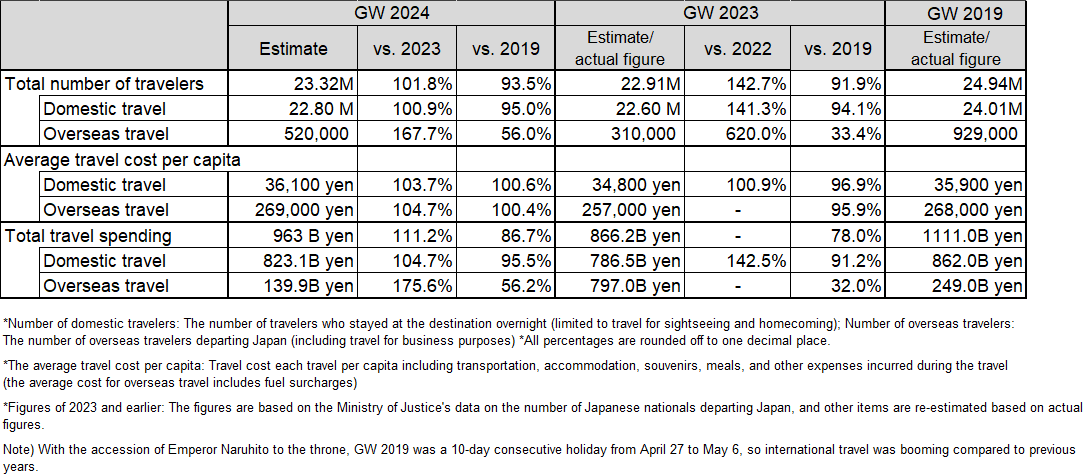
1. 2024 GW Calendar and Travel Trends

GW 2024 will be the first GW following the downgrading of COVID-19 to a Class 5 infectious disease on May 8, 2023. This year's GW calendar has a three-day long weekend from Saturday, April 27 to Monday, April 29 (national holiday) and a four-day long weekend from Friday, May 3 (national holiday) to Monday, May 6 (substitute national holiday). Taking Tuesday, April 30, Wednesday, May 1, and Thursday, May 2, off, a total of 10 consecutive days off from Saturday, April 27, is possible. The survey mentioned earlier was designed to capture detailed findings on travel intentions, including homecoming trips, for GW 2024 (April 25 to May 5).
Regarding whether or not people will travel during GW, 26.5% of the respondents said they will (a combined score of those who will and probably will go somewhere), which is the same as last year. The pre-pandemic score for 2019 was 26.3%, indicating that travel intentions have recovered to the same level as before COVID-19 this year as well (Figure 2). By gender and age, the younger the age group, the higher the travel intention is for both men and women compared to last year when the travel intentions notably recovered across all age groups (Figure 3). The breakdowns of respondents with travel intentions were 40.5% of men, up 0.3 points, and 39.8% of women, up 2.5 points, among those aged 29 and younger, and 14.5% of men, down 5.0 points, and 14.1% of women, down 0.5 points, among those in their 70s.
The most common reason for not traveling was "Everywhere is crowded during GW" (47.2%), up 4.7 points from the previous year. Next in line were financial reasons such as "Travel cost is higher during GW" (33.7%) and "I cannot afford to travel" (24.0%). Since the answer, "I relax at home during GW every year" (18.6%) is a new choice, the data is for reference purposes only, but compared to a similar answer for the previous year, "I want to relax at home" (26.1%), there was a 7.5-point decrease (Figure 4).
(Figure 2) Intention of travel during GW (single answer, N=10,000)

(Figure 3) Intention of travel during GW (by gender and age, single answer, N=10,000)
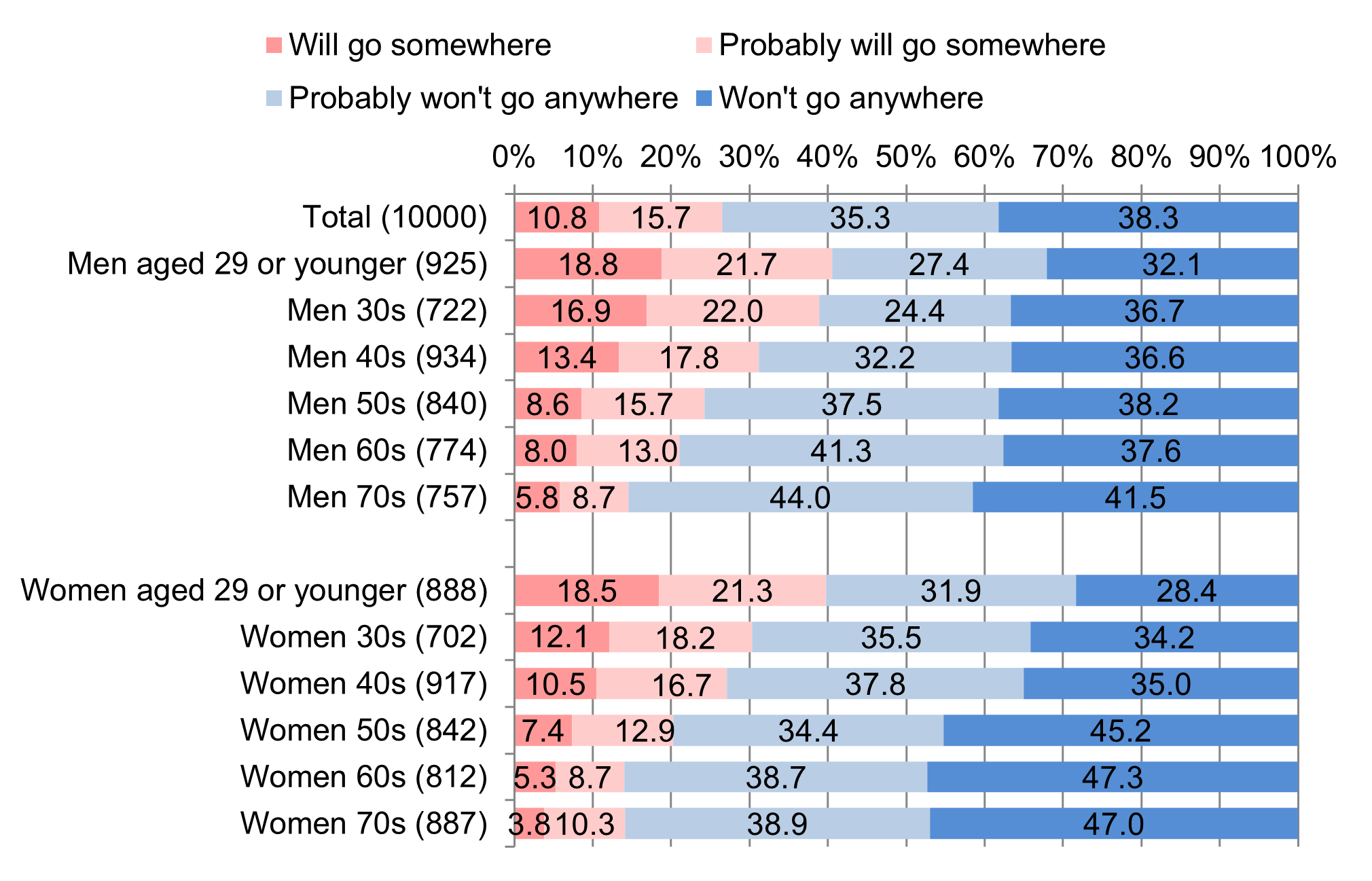
(Figure 4) Reasons for having no intention to travel during GW this year (multiple answers, N=7,351)
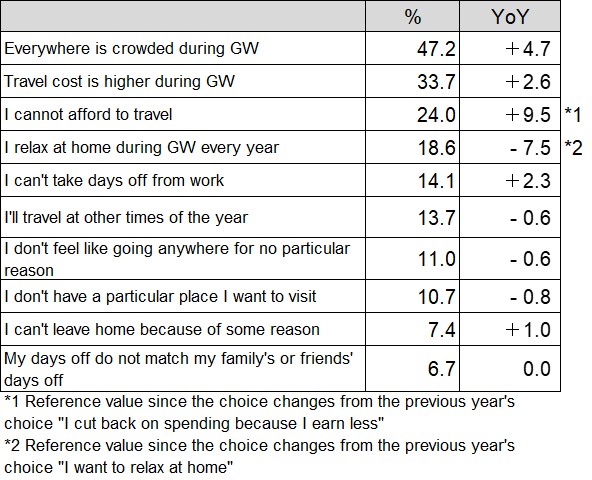
The 2,060 respondents for the survey who said they will or probably will go somewhere in GW were asked for details about their trip. This year, the most popular option, selected by 21.8% of the respondents, was "I'll spend more days on travel than last year" and significantly exceeded "I'll spend fewer days on travel than last year" (8.6%) unlike the previous year when COVID-19 may still have had an effect on the decision to travel during GW since the end of the entry-exit border control measures for COVID-19 was announced right before GW. In addition, "I'll go to a farther place than last year" (13.9%) exceeded "I'll go to a closer place than last year" (8.2%) by 5.7 points. This result shows more people are looking to travel longer and farther than the previous year (Figure 5).
(Figure 5) Details about the trip during GW (Multiple answers, N=2,060)
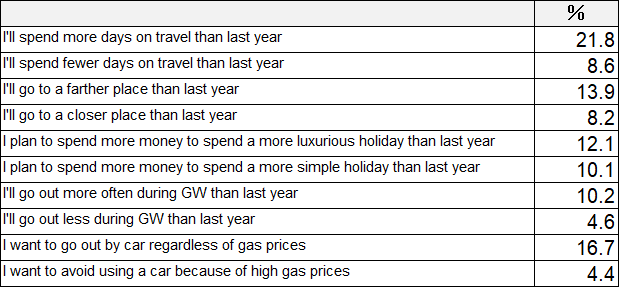
- Golden Week Domestic Travel Trends
The number of domestic travelers is estimated at 22.80 million (100.9% year-on-year), the average cost for domestic travel at 36,100 yen (103.7% year-on-year), and the total domestic travel spending at 823.1 billion yen (104.7% year-on-year) (Figure 1).
We analyzed the trends of 1,964 respondents who selected domestic destinations out of the respondents to the main survey (2,060) about travel during GW this year.
Departure date for travel: "Friday, May 3 (national holiday)" (20.8%) was the most common response, followed by "Saturday, April 27" (16.6%), suggesting that there are two peak dates for departure for travel in the three-day weekend earlier in GW and the four-day weekend later in GW (Figure 6).
Travel duration (days): Overall, "Overnight" (37.7%) was the most common choice, but this was a 1.2-point drop from the previous year. While the score of 2 nights" (33.9%) increased by 0.2 points, those of "3 nights" (17.1%) went up by 1.7 points. Perhaps because it was easier to take more days off due to the calendar last year, the number of respondents who selected 6 nights or longer slightly decreased (Figure 7).
Travel purposes and motivation (overall): "Spend time with family" (31.7%) was the most popular selection, followed by "Relax and unwind" (28.9%) and "Enjoy meals and local cuisine" (28.5%) (Figure 8).
Destinations (domestic): "Kanto" (20.1%) was the most popular destination, followed by "Kinki" (16.7%) and "Tokai" (12.8%) (Figure 9).
As reasons for selecting the destination, "There's somewhere I want to visit" (45.2%) was the most common reason for selecting the destination, up 2.8 points from the previous year, followed by "I can go there by my car or rent-a-car" (21.0%) and "It is my hometown" (18.4%). In addition, although the percentage is small, "The destination does not seem to be crowded with tourists" (7.0%) enjoyed the largest growth with a 4.5-point increase from the previous year (Figure 10). Observing travel destinations by area of residence, the percentages of intra-regional travel, i.e., travel destination and place of residence are in the same area, were over 60% in the two areas, "Hokkaido" (62.5%) and "Kyushu" (60.7%), while the percentages were 30.2% in "Kinki" and 31.1% in "Kanto." This result suggests popular travel destinations spread to neighboring regions (Figure 11). Compared to the previous year, the percentage of intra-regional travel was down in Hokkaido, Kinki, Chugoku and Shikoku, and Kyushu. On the other hand, the percentage of intra-regional travel went up in Tohoku, Kanto, and Chubu, indicating different characteristics depending on the region (Figure 12).
Travel companions: "Family travel with children (up to those in junior high)" (25.0%) scored the highest, up by 1.7 points from the previous year, followed by "Married couples only" (22.9%) and "With friends, acquaintances, or a partner" (15.8%) (Figure 13).
Travel cost per capita: Overall, "10,000 to under 20,000 yen" (20.2%) and "20,000 to under 30,000 yen" (20.2%) ranked first with the same percentage but both saw a decline from the previous year. These choices were followed by "40,000 to under 50,000 yen" (17.5%), up 3.6 points from the previous year. The total score of 30,000 yen or more increased by 4.7 points from the previous year, which shows the overall increasing trend (Figure 14).
Transportation used: "Private car" ranked top at 55.3% followed by "JR Shinkansen" (23.8%) and "JR local services, private railways" (19.7%). By category, "Private car, rent-a-car" declined by 1.0 point while "Railroad" increased by 2.2 points and "Airplane" increased by 3.1 points (Figure 15).
Accommodations used (*Multiple answers are accepted from this year): "Hotel" (60.8%) was the most popular choice. This was followed by "Japanese inn" (26.3%) and "Parents' or relatives' house" (20.3%) (Figure 16).
The most popular option for interesting places to visit during this GW was "Places to enjoy nature (to enjoy sceneries, such as national parks and flower fields)" (26.1%), followed by "Places to enjoy nature (to enjoy experiences, such as mountain climbing and other outdoor activities)" (15.8%) (Figure 17).
JTB's reservations for accommodation and domestic package products increased by 100% compared to the previous year (total number of people as of April 3, 2024). Among destinations, Tokyo (including Tokyo Disney Resort®) and Kansai (including Universal Studios Japan) are performing exceptionally well due to seasonal only events. Distant destinations accessed by air such as Okinawa and Kyushu are also popular.
(Figure 6) Departure date for travel (single answer)
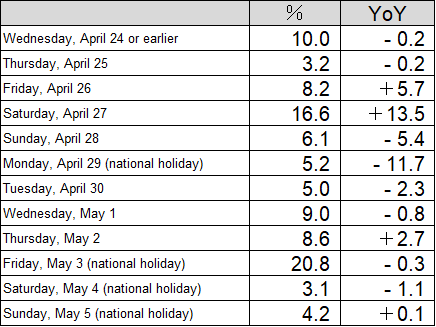
(Figure 7) Travel duration (days) (single answer)
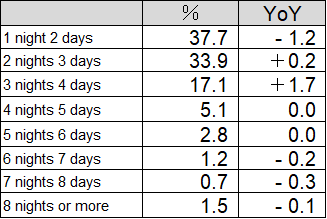
(Figure 8) Travel purposes and motivations (multiple answers)
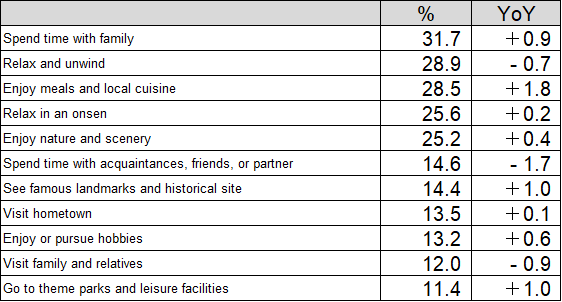
(Figure 9) Travel destinations (single answer)
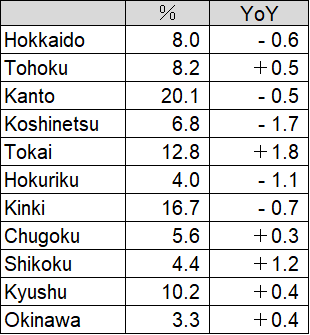
(Figure 10) Reasons for selecting the destination (multiple answers)
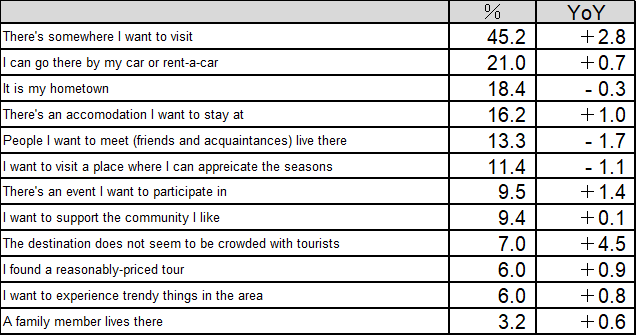
(Figure 11) Travel destinations for GW by area of residence (by area, single answer, N=2,060)
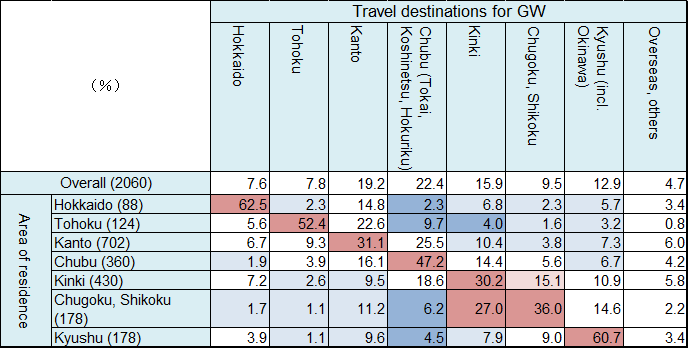
(Figure 12) YoY change in GW destinations by area of residence (by area, single answer, N =2,060)
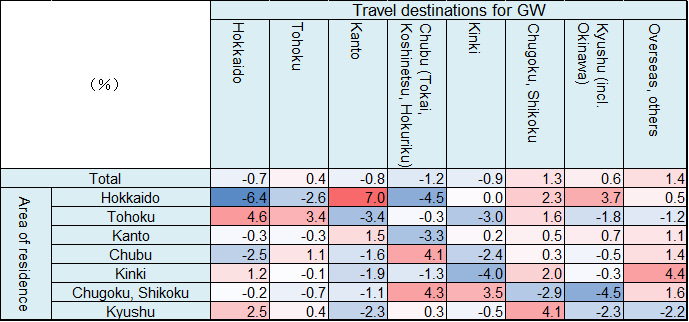
*To understand overall trends, Figures 11 and 12 only include travelers heading overseas
(Figure 13) Travel companions (single answer)
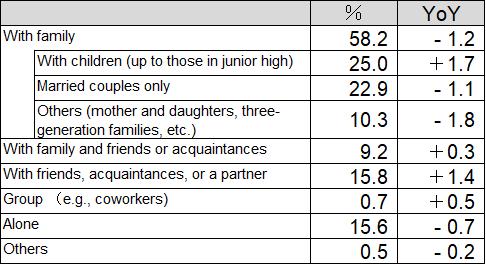
(Figure 14) Travel cost per capita (single answer)
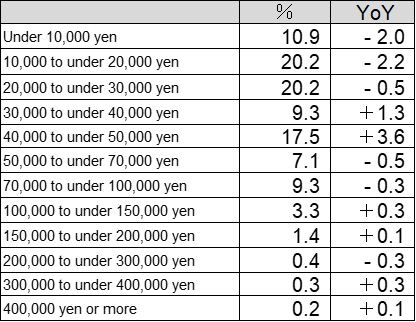
(Figure 15) Transportation used (multiple answers)
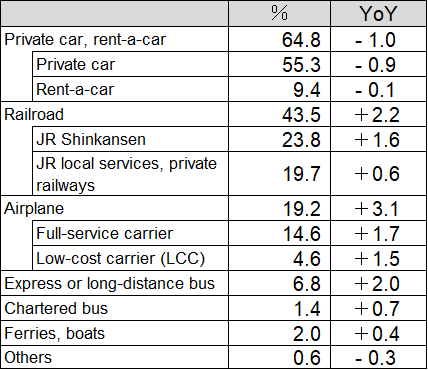
(Figure 16) Accommodation used (multiple answers)
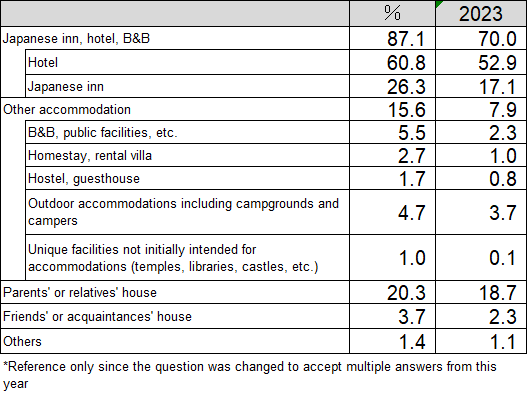
(Figure 17) Types of interesting places to visit during this GW (by gender and age group, multiple answers)
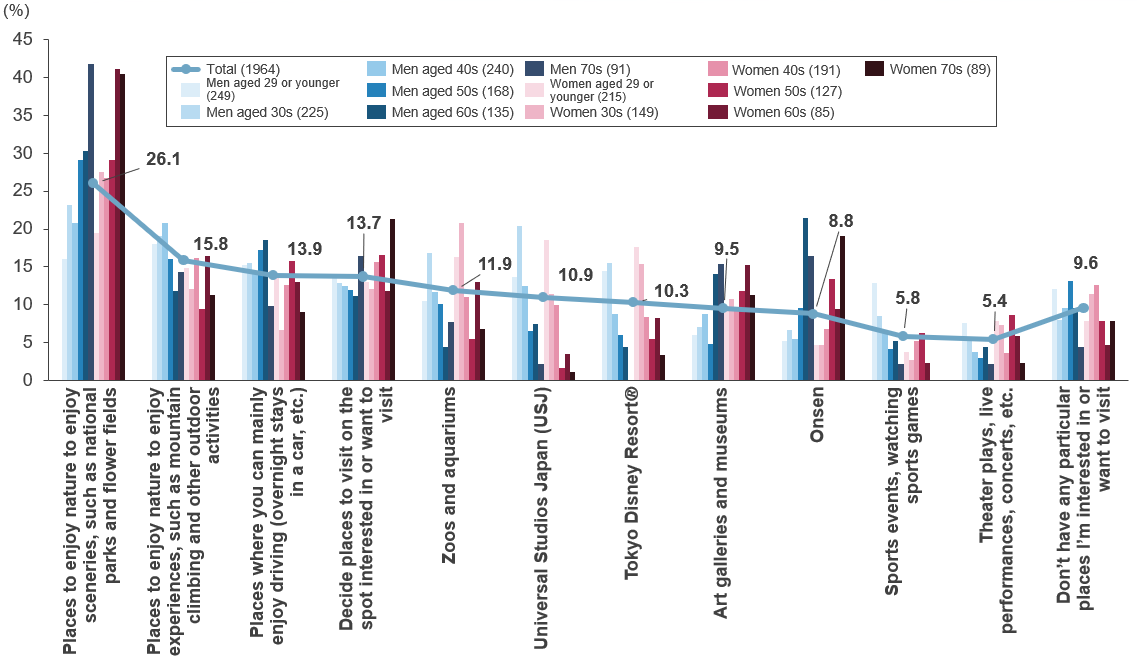
*N=1,964 for Figures 6 to 10 and 13 to 17
- Overseas Travel Trends
We estimated the number of overseas travelers at 520,000 (167.7% vs. 2023, 56.0% vs. 2019). Last year, the lifting of the entry-exit border control measures for COVID-19 was announced on April 28 just before GW. Consequently, a certain number of people are assumed to have given up overseas travel, and a rebound is expected this year. In 2019, with the accession of Emperor Naruhito to the throne, GW was a 10-day consecutive holiday from April 27 to May 6, so international travel flourished compared to previous years. The number of overseas travelers during GW in the five years from 2014 to 2018 hovered around 550,000 each year, and compared to that average, the number of overseas travelers for this GW is estimated to recover to almost 90%. The average cost for overseas travel is 269,000 yen (104.7% year-on-year), and the total overseas travel spending was 139.9 billion yen (175.6% year-on-year). Specific trends will be described in the following chapters.
Out of 2,060 respondents for the main survey, 96 respondents (4.7%) selected overseas as a travel destination during this GW. The peak departure date is "Saturday, April 27" (18.8%) followed by "Wednesday, April 24 or earlier" (17.7%) and "Friday, April 26" (13.5%) (Figure 18). The most popular travel duration is "3 nights and 4 days" (27.1%) followed by "2 nights and 3 days" (16.7%) (Figure 19). For travel costs, "70,000 to under 100,000 yen" (18.8%) is ranked at the top followed by "400,000 yen or more" (16.7%) and "200,000 to under 300,000 yen" (15.6%) (Figure 20). Popular destinations from the top were "South Korea" (20.8%), "Southeast Asia" (16.7%), and "Taiwan" (13.5%). As additional information, in 2019 when GW was a 10-day consecutive holiday, "Southeast Asia" (19.6%), "Europe" (15.5%), and "Hawaii" (12.8%) were ranked as popular destinations (Figure 21).
JTB's reservations for overseas travel increased by 225% (number of travelers, as of April 3, 2024) compared to the previous year. Destinations where travelers can visit in a short number of days such as Asia and Hawaii are popular. April 27 and 28 are peak departure dates for long-distance travel and May 2 and 3 for short-distance travel.
The respondents to the preliminary survey including those who will not travel during this GW were asked about their intentions for future overseas travel. According to timing for overseas travel by destination, "I want to go soon" is the most popular for "Hawaii" (12.6%) followed by "Europe" (11.5%) and "Taiwan" (9.9%) (Figure 22)
(Figure 18) Departure date for travel (single answer)
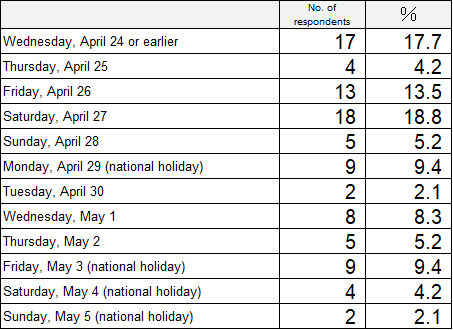
(Figure 19) Travel duration (days) (single answer)
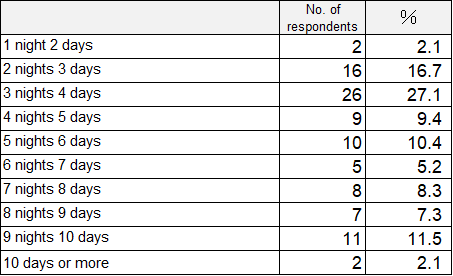
(Figure 20) Travel cost per capita (single answer)
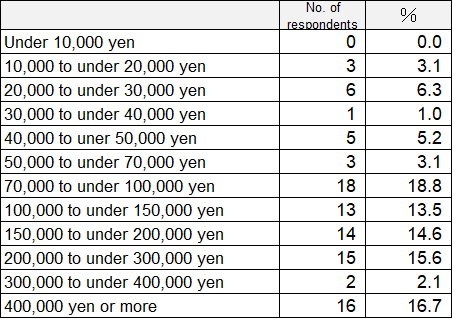
(Figure 21) Destinations (single answer)
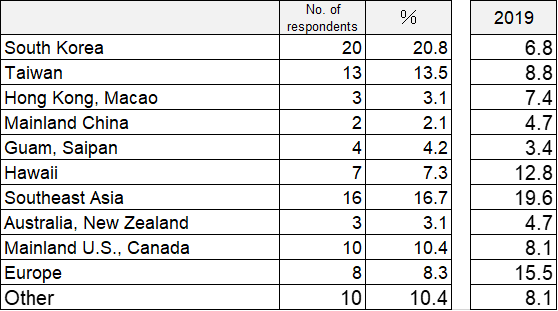
(Figure 22) Intentions for future overseas travel by destination (single answer, N=10,000 *Those who are subject to the screening survey)
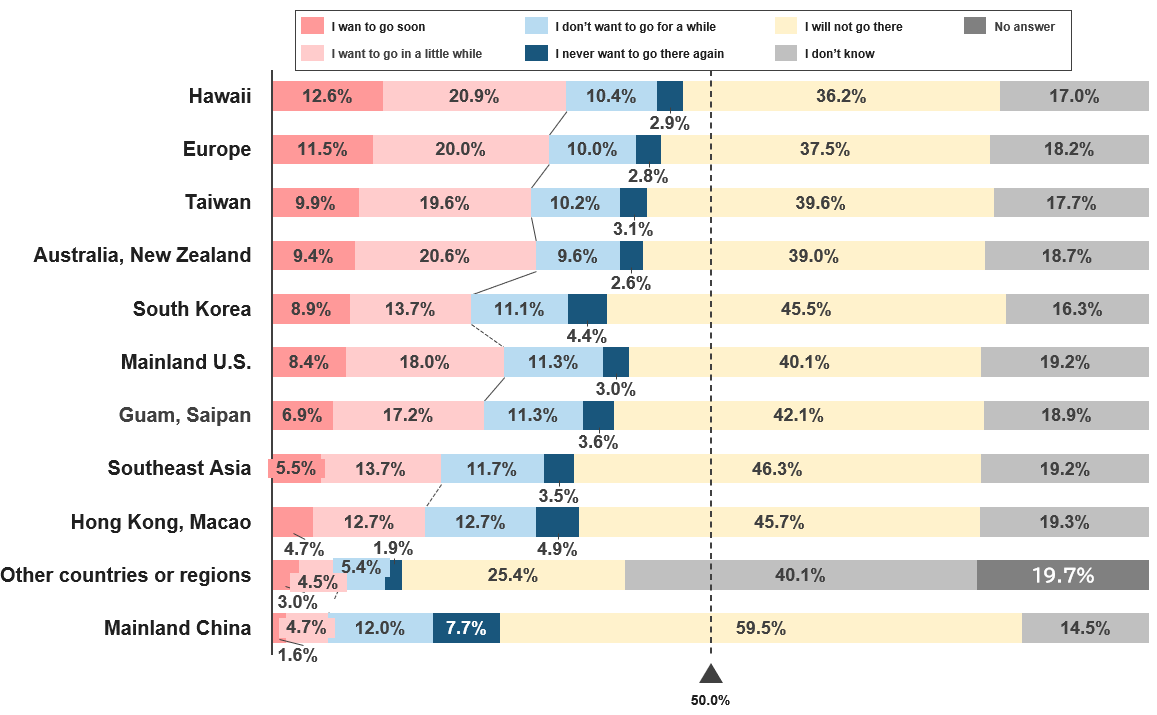
*N=96 for Figures 18 to 21
- Economic Environment Surrounding Travel and Leisure Consumption and Sei-katsu-sha Mindset
Although there is almost no impact from COVID-19, the unstable international context continues, and prices remain high domestically and globally in spite of the slowing upward trend. The Nikkei Stock Average hit a record high in February 2024 and temporarily rose to the 40,000-yen level in March. Japan's stock market is booming, but on the other hand, the value of the Japanese yen continues to be weak, which contributes to price hikes in Japan. The assessment of the current state of the Japanese economy in the February 2024 Monthly Economic Report was downwardly revised and states that "the Japanese economy is recovering at a moderate pace, although it recently appears to be pausing." Personal consumption was also downgraded for the first time in two years. According to the above-mentioned February 2024 Monthly Economic Report, consumption is expected to pick up, supported by the improvement in employment and income situations. On the other hand, slowing down of overseas economies is a downside risk of the Japanese economy. In addition, the report stated that full attention should be given to price increases, the situation in the Middle East, fluctuations in the financial and capital markets, and the economic impact of the 2024 Noto Peninsula Earthquake.
The consumer price index is high for primary items except for "Transportation and communication" and a gradual increasing trend can be identified in "Transportation and communication" as well, which indicates the impact of people's daily lives (Figure 23). Nonetheless, according to the Bank of Japan's latest December 2023 "Opinion Survey on the General Public's Views and Behavior," more respondents selected "Have become better off" for the "present household circumstances" and the percentage of respondents who selected "Have become worse off" took a downward turn. In the backdrop of price hikes, an improvement trend can be seen although the improvement is slight (Figure 24).
In the question asking to select the statement that best describes their daily lives and GW travel in a survey conducted by JTB, the growth of "My income is likely to decrease due to worsened performance at work and of the company I work for" (13.6%) is larger than the growth of "My income is likely to increase due to better performance at work and of the company I work for" (7.5%), which indicates a difficult income situation. On the contrary, "We have enough money in our household" (5.0%) grew larger than "We don't have enough money in our household" (24.6%), indicating a slight increase of household funds. In this background, "I try to spend less money on hobbies and travel" (16.6%) decreased from the previous year while "I don't try to spend less money on hobbies and travel" (7.1%) increased. In addition, "I want to hold back on big spending due to future uncertainties" (16.8%) decreased from the previous year and "I want to think about spending big now due to future uncertainties" (5.3%) increased, implying the tendency of not holding back on spending on hobbies or travel (Figure 25).
Regarding "Spending intention on travel in the next year," "About the same" increased from the previous year and both "I want to spend more" (14.5%) and "I want to spend less" (35.3%) declined. Spending on travel does not appear to be significantly different from last year (Figure 26).
Lastly, in the question about "Concerns about travel in the next year" for domestic and overseas travel respectively, in domestic travel, "High prices" (36.1%) tends to be a popular concern in every age group while the concern that "Tourism destinations are crowded with visitors from overseas" (31.8%) is quite notable in higher age groups. For overseas travel, the most popular answer was "Ongoing weak yen" (44.4%), and the future of the currency market needs to be monitored (Figure 27).
(Figure 23) Transition of the consumer price index
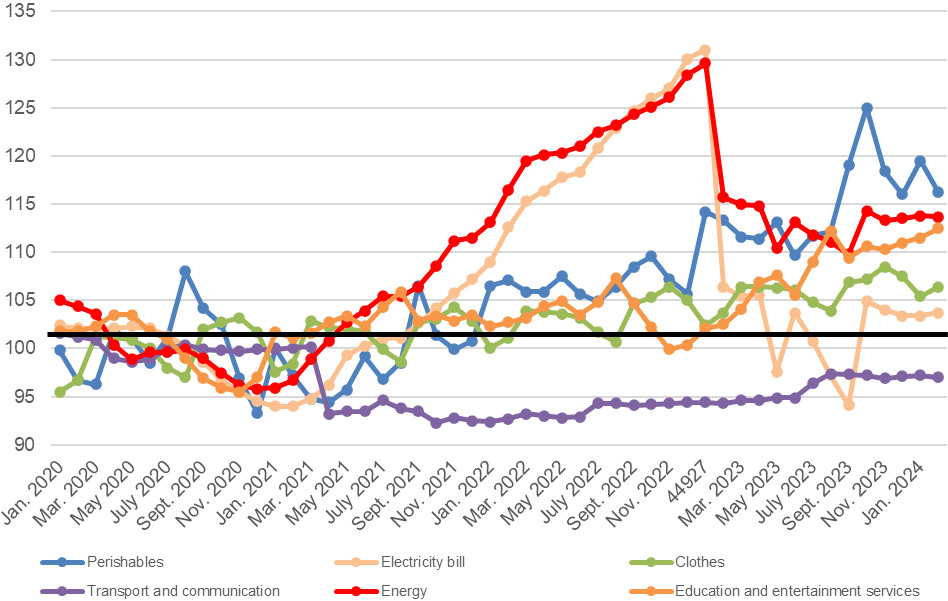
Source:Prepared by JTB Tourism Research & Consulting Co. based on data from the Consumer Price Index (2020 base), Ministry of Internal Affairs and Communications
(Figure 24) Present household circumstances
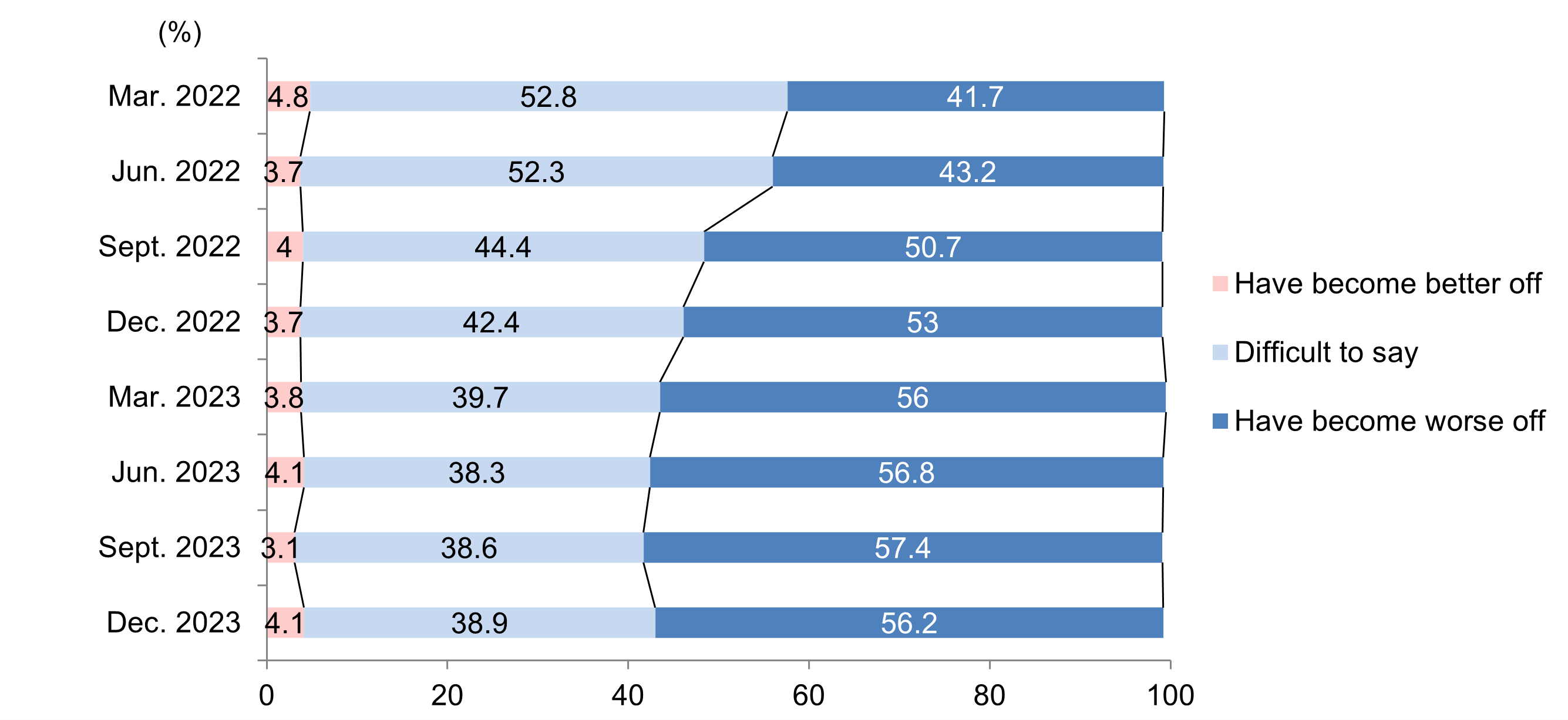
Source:Prepared by JTB Tourism Research & Consulting Co. based on data from an Opinion Survey on the General Public's Views and Behavior, Bank of Japan
(Figure 25) Respondents' current life and GW (multiple answers, N=10,000)

(Figure 26) Spending intention on travel in the next year (single answer, N=10,000)
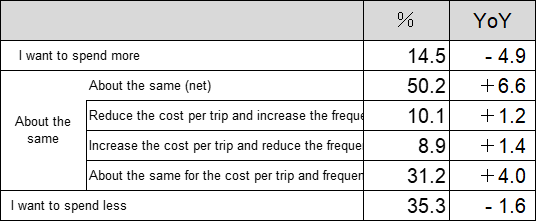
(Figure 27) Concerns about travel in the next year (multiple answers, N=10,000)
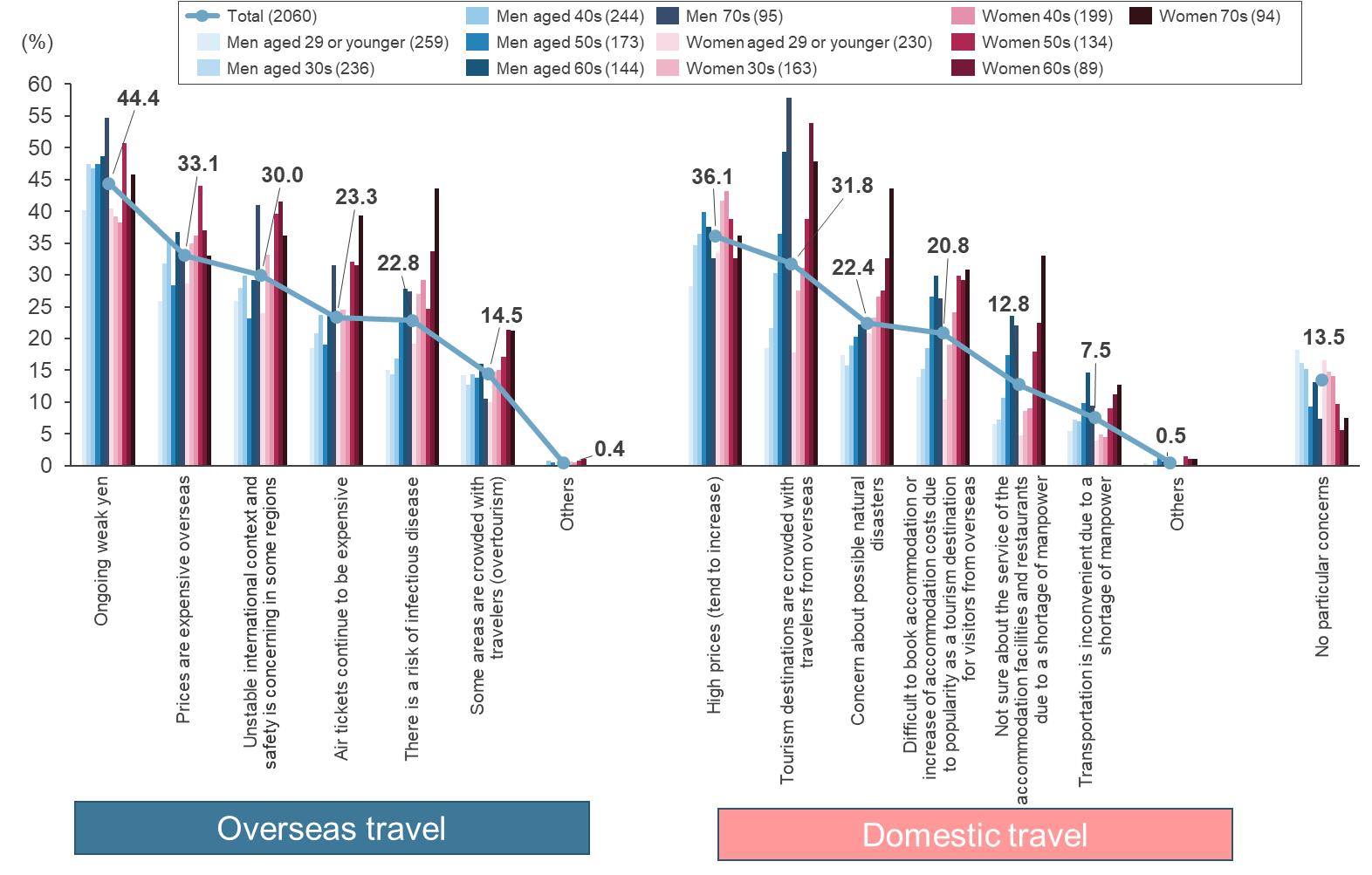
[Travel trend survey: survey methodology]
Survey dates:March 7 to March 13, 2024
Respondents:Men and women aged 15 to 79 nationwide
Sample size:10,000 for the preliminary survey and 2,060 for the main survey
(The main survey was conducted only with those who responded in the preliminary survey that they will or probably will travel during GW.)
Survey focus:Overnight or multiple-night travel planned for April 25 to May 5, 2024
(Domestic travel is limited to sightseeing and homecoming trips. Overseas travel includes business trips.)
Survey methodology: Online survey
*Since survey results data are rounded off, differences from sub totals and survey results of the previous year do not match for some figures.
(Figure 28) Transition in the number of travelers in GW and estimated cost for travel
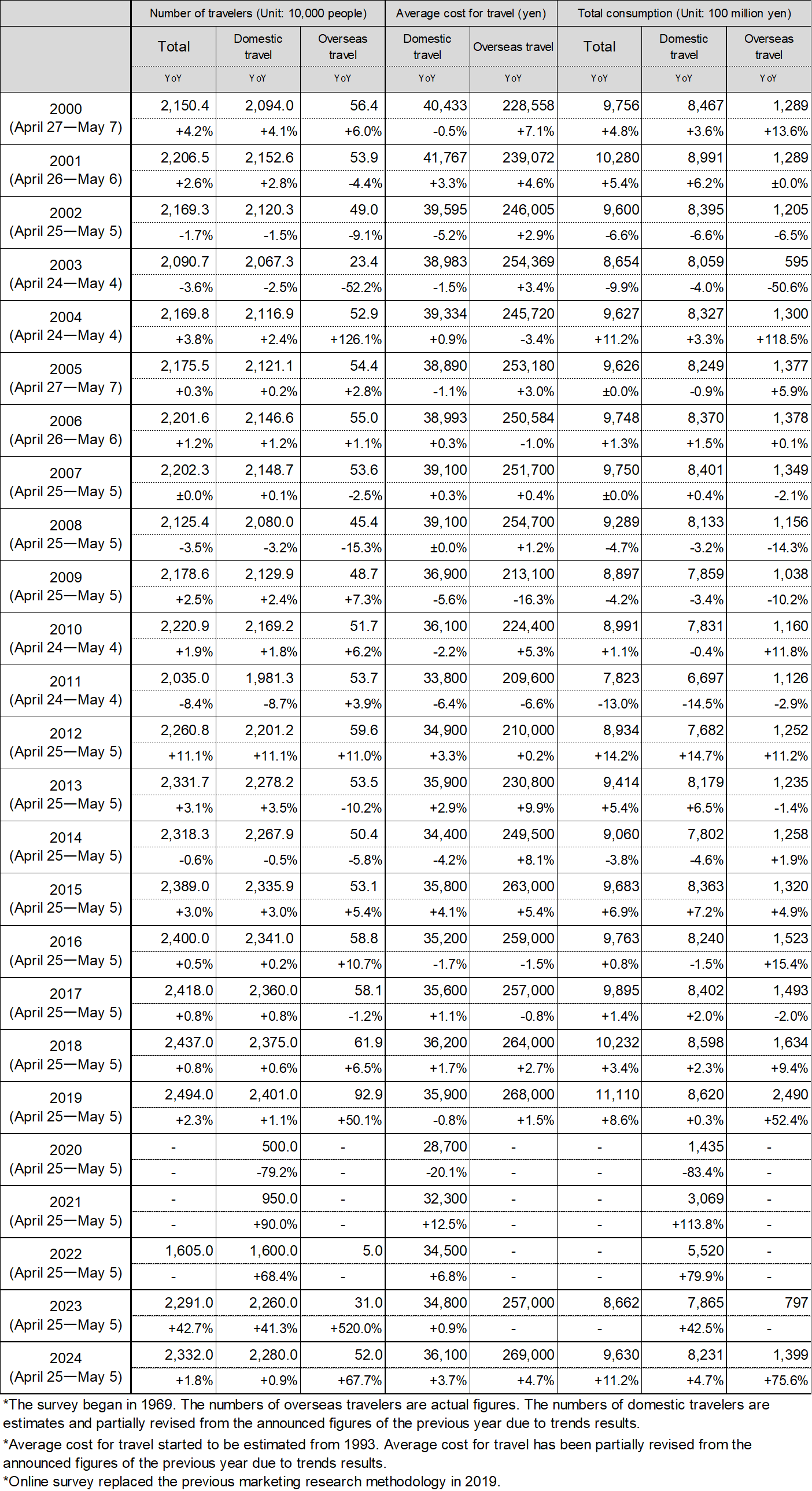
JTB Corp. Branding & Communication Team (Public Relations)
Phone: +81 3 5796 5833
